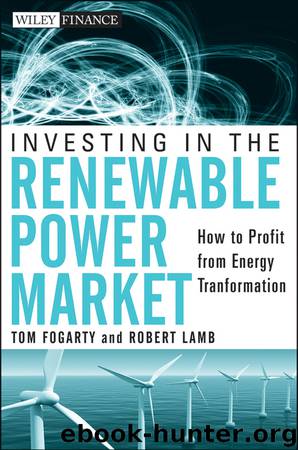Investing in the Renewable Power Market by Tom Fogarty & Robert Lamb

Author:Tom Fogarty & Robert Lamb
Language: eng
Format: epub
Publisher: Wiley
Published: 2012-01-24T16:00:00+00:00
Wind Energy Prediction
One of the challenges for wind projects comes from the projection of future production of electricity. Future megawatt hour production is calculated based on both on site and windspeed data from local sources such as an airport. One wind project investor stated that on its 54 wind farms, based on 90 years’ worth of data, they had been underperforming by 10 to 11 percent. This is due to less wind turbine availability, wake effect due to terrain layout, and errors in the ultimate calculation from gross to net electric output. A drop in an availability of 10 percent would result in a drop in a typical wind project internal rate of return of 300 basis points. As wind turbines got taller, correlation with lower height meteorological towers produced bad data. Some developers have invested in met towers that are the same height as the actual wind turbines’ hubs.
In Germany, for the first quarter of 2010 the Breeze Two wind project recorded wind conditions at 81 percent of the long-term average. The project's financial structure was based on more optimistic wind forecasts. As a result, the Class B debt of Breeze Two has been downgraded to C by Standard and Poor's, with a negative outlook.7
The main tool for assessing the wind resources at prospective wind farm sites is “measure, correlate, predict” (MCP) analysis. This involves comparing a short-term sample wind measurement at the site itself with years’ worth of historical wind data taken from a nearby airport or permanent weather station. Using statistical models to take account of the difference between the target site and the reference site, developers can then build a detailed picture of the potential wind resources.8
Prediction of wind turbine output has been especially unreliable in complex terrain areas. These are locations with forests and mountains. To improve wind generation predictions, some companies are turning to laser- and sonar-based measurement instruments to complement MCP. In Denmark, which already gets nearly 20 percent of its electricity from wind power, a change in wind speed of one meter per second can translate into a change of 450 mW in national power output.9
Lenders to wind projects consider a P99, P90, and a P50 output. These outputs each have different percent chances, as follows:
For a P50 output, there is a 50 percent chance that the wind project output will be higher than this value and a 50 percent chance it will be lower than this value.
For a P90 output, there is a 90 percent chance that the wind project output will be higher than this value and a 10 percent chance it will be lower than this value.
For a P99 output, there is a 99 percent chance that the wind project output will be higher than this value and a 1 percent chance it will be lower than this value.
Download
This site does not store any files on its server. We only index and link to content provided by other sites. Please contact the content providers to delete copyright contents if any and email us, we'll remove relevant links or contents immediately.
Learning SQL by Alan Beaulieu(6237)
Weapons of Math Destruction by Cathy O'Neil(6214)
Digital Minimalism by Cal Newport;(5702)
iGen by Jean M. Twenge(5384)
Sapiens by Yuval Noah Harari(5321)
The Age of Surveillance Capitalism by Shoshana Zuboff(4243)
Elon Musk by Ashlee Vance(4082)
Thing Explainer by Randall Munroe(3909)
Apollo 8 by Jeffrey Kluger(3667)
Future Crimes by Marc Goodman(3562)
The Science Book (Big Ideas Simply Explained) by DK(3252)
Who Can You Trust? by Rachel Botsman(3110)
The Innovators: How a Group of Hackers, Geniuses, and Geeks Created the Digital Revolution by Walter Isaacson(2991)
I Live in the Future & Here's How It Works by Nick Bilton(2958)
Infinite Energy Technologies by Finley Eversole(2952)
Steve Jobs by Walter Isaacson(2857)
Dawn of the New Everything by Jaron Lanier(2751)
Chernobyl by Serhii Plokhy(2514)
Ben Franklin's Almanac by Candace Fleming(2492)
